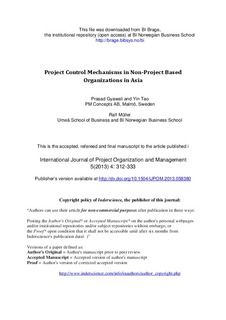| dc.contributor.author | Gyawali, P | |
| dc.contributor.author | Tao, Y | |
| dc.contributor.author | Müller, Ralf | |
| dc.date.accessioned | 2016-07-28T11:45:20Z | |
| dc.date.accessioned | 2016-08-19T12:33:32Z | |
| dc.date.available | 2016-07-28T11:45:20Z | |
| dc.date.available | 2016-08-19T12:33:32Z | |
| dc.date.issued | 2013 | |
| dc.identifier.citation | International Journal of Project Organisation and Management 2013, 5(4):312-333 | nb_NO |
| dc.identifier.issn | 1740-2905 | |
| dc.identifier.uri | http://hdl.handle.net/11250/2400091 | |
| dc.description | This is the accepted, refereed and final manuscript to the article | nb_NO |
| dc.description.abstract | Projects play a key role in implementing strategy. Organizations of all kinds implement projects. As the importance of the projects grow, their monitoring and controlling becomes crucial for strategy achievement. However, non-project based organizations lack distinctive project management approaches, their projects are controlled and monitored by the inherent control system of the functional organization. Several studies highlighted the variance in organizational control mechanisms. However, there is a dearth of these studies done in the context of project. One recent study done by Nieminen and Lehtonen (2008) however, done in a program context and focusing on organizational change revealed three organizational control mechanisms and 23 control tools being used in four case programs. Building on studies outlining the need for a contingency between project type and project management approach, this study focuses on understanding how the control mechanisms vary across different types of projects executed by non-project based organizations employing the project classification developed by Turner and Cochrane (1993).
A qualitative study employing semi-structured interviews was conducted with nine project managers of seven companies from China and Nepal. The study revealed the dominance of distinct organizational control mechanisms contingent on type of project, even though there was presence of all types of organizational control mechanisms in the sampled projects. Furthermore, the application of the control tools within a control mechanism varied across projects of similar type. Results are important for organizations with little project orientation in order to align their control mechanisms to the types of projects they have. | nb_NO |
| dc.language.iso | eng | nb_NO |
| dc.publisher | Inderscience | nb_NO |
| dc.title | Project Control Mechanisms in Non-Project-Based Organizations in Asia | nb_NO |
| dc.type | Journal article | nb_NO |
| dc.type | Peer reviewed | nb_NO |
| dc.date.updated | 2016-07-28T11:45:20Z | |
| dc.source.journal | International Journal of Project Organisation and Management | nb_NO |
| dc.identifier.doi | 10.1504/IJPOM.2013.058380 | |
| dc.identifier.cristin | 1075731 | |
| dc.description.localcode | 1, Forfatterversjon | nb_NO |
